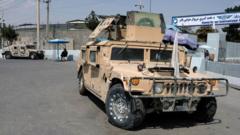Recent investigations indicate a staggering loss of over half a million US weapons in Afghanistan, following the Taliban's takeover in 2021, with many sold or smuggled to affiliated militant organizations, raising serious security concerns.
US Weapons in Afghanistan Sold to Militants: Alarming Developments Unfold

US Weapons in Afghanistan Sold to Militants: Alarming Developments Unfold
Former Afghan officials reveal that military equipment seized by the Taliban is now in the hands of various militant groups.
According to reports, more than 500,000 weapons originally acquired by the Taliban during their rapid ascendance in Afghanistan are now unaccounted for, having been lost or sold to various militant factions. Reliable sources informed the BBC that parts of this military hardware have reportedly made their way to affiliates of al-Qaeda.
Former Afghan officials, who spoke to the BBC under anonymity, disclosed that when the Taliban reclaimed power in 2021, they took possession of approximately one million items of military equipment largely funded by the United States. This included an array of American-made firearms such as M4 and M16 rifles, as well as other weapons dating back to decades of prior conflict. Many Afghan soldiers surrendered or fled, abandoning their arms and vehicles in the initial phase of the Taliban's advance.
At a closed-door UN Security Council's Sanctions Committee meeting held last year in Doha, Taliban representatives admitted that half of the captured equipment remains "unaccounted for," corroborated by additional world body sources. A UN report from February has identified connections between Taliban-held weapons and various militant groups, including Tehreek-e-Taliban Pakistan, the Islamic Movement of Uzbekistan, and Yemen's Ansarullah, with some acquiring arms from Taliban stockpiles or prevailing black markets.
Hamdullah Fitrat, deputy spokesperson for the Taliban, defended the government's claims, insisting that weapon storage and protection are a high priority, even as they refuted charges of smuggling and loss. However, a UN 2023 report highlighted that local Taliban commanders are allowed to keep 20% of seized arms, fostering a thriving black market. This underground network reportedly facilitates arms trading through platforms like WhatsApp, revealing a troubling arms market that persists beyond the Taliban's official narrative.
Furthermore, the Special Inspector General for Afghanistan Reconstruction (SIGAR) has indicated challenges regarding inaccurate tracking of equipment due to the complexities involved in the multiple channels of supply and funding over the past decades.
The claims regarding the lost weaponry present a contentious political issue in the U.S., with former President Donald Trump asserting the need to reclaim military assets left behind—declaring an estimated $85 billion worth of arms may be at stake. Nonetheless, such figures are contested, with contractors, personnel training, and salaries also included in the financial estimates.
Zabihullah Mujahid, Taliban's chief spokesperson, dismissed Trump's comments, asserting that the weapons were seized from the previous administration, emphasizing their legitimate use for national defense. With the Pentagon's assertion that the hardware left was rendered inoperable, the Taliban has nonetheless not only showcased this arsenal as a symbol of victory but has actively utilized it against rival groups like the Islamic State Khorasan.
In conclusion, while Trump’s determination to reclaim U.S. military resources may garner attention, experts warn against the practicality of such measures, suggesting that it might be futile. Current anxieties about the proliferation of these arms and their accessibility to extremist factions continue to pose significant challenges.





















